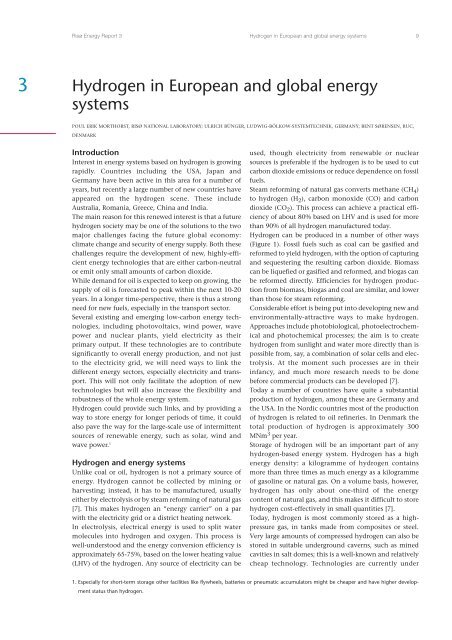Hydrogen and its competitors, 2004
Hydrogen and its competitors, 2004
Hydrogen and its competitors, 2004
Create successful ePaper yourself
Turn your PDF publications into a flip-book with our unique Google optimized e-Paper software.
Risø Energy Report 3<strong>Hydrogen</strong> in European <strong>and</strong> global energy systems 93<strong>Hydrogen</strong> in European <strong>and</strong> global energysystemsPOUL ERIK MORTHORST, RISØ NATIONAL LABORATORY; ULRICH BÜNGER, LUDWIG-BÖLKOW-SYSTEMTECHNIK, GERMANY; BENT SØRENSEN, RUC,DENMARKIntroductionInterest in energy systems based on hydrogen is growingrapidly. Countries including the USA, Japan <strong>and</strong>Germany have been active in this area for a number ofyears, but recently a large number of new countries haveappeared on the hydrogen scene. These includeAustralia, Romania, Greece, China <strong>and</strong> India.The main reason for this renewed interest is that a futurehydrogen society may be one of the solutions to the twomajor challenges facing the future global economy:climate change <strong>and</strong> security of energy supply. Both thesechallenges require the development of new, highly-efficientenergy technologies that are either carbon-neutralor emit only small amounts of carbon dioxide.While dem<strong>and</strong> for oil is expected to keep on growing, thesupply of oil is forecasted to peak within the next 10-20years. In a longer time-perspective, there is thus a strongneed for new fuels, especially in the transport sector.Several existing <strong>and</strong> emerging low-carbon energy technologies,including photovoltaics, wind power, wavepower <strong>and</strong> nuclear plants, yield electricity as theirprimary output. If these technologies are to contributesignificantly to overall energy production, <strong>and</strong> not justto the electricity grid, we will need ways to link thedifferent energy sectors, especially electricity <strong>and</strong> transport.This will not only facilitate the adoption of newtechnologies but will also increase the flexibility <strong>and</strong>robustness of the whole energy system.<strong>Hydrogen</strong> could provide such links, <strong>and</strong> by providing away to store energy for longer periods of time, it couldalso pave the way for the large-scale use of intermittentsources of renewable energy, such as solar, wind <strong>and</strong>wave power. 1<strong>Hydrogen</strong> <strong>and</strong> energy systemsUnlike coal or oil, hydrogen is not a primary source ofenergy. <strong>Hydrogen</strong> cannot be collected by mining orharvesting; instead, it has to be manufactured, usuallyeither by electrolysis or by steam reforming of natural gas[7]. This makes hydrogen an “energy carrier” on a parwith the electricity grid or a district heating network.In electrolysis, electrical energy is used to split watermolecules into hydrogen <strong>and</strong> oxygen. This process iswell-understood <strong>and</strong> the energy conversion efficiency isapproximately 65-75%, based on the lower heating value(LHV) of the hydrogen. Any source of electricity can beused, though electricity from renewable or nuclearsources is preferable if the hydrogen is to be used to cutcarbon dioxide emissions or reduce dependence on fossilfuels.Steam reforming of natural gas converts methane (CH 4 )to hydrogen (H 2 ), carbon monoxide (CO) <strong>and</strong> carbondioxide (CO 2 ). This process can achieve a practical efficiencyof about 80% based on LHV <strong>and</strong> is used for morethan 90% of all hydrogen manufactured today.<strong>Hydrogen</strong> can be produced in a number of other ways(Figure 1). Fossil fuels such as coal can be gasified <strong>and</strong>reformed to yield hydrogen, with the option of capturing<strong>and</strong> sequestering the resulting carbon dioxide. Biomasscan be liquefied or gasified <strong>and</strong> reformed, <strong>and</strong> biogas canbe reformed directly. Efficiencies for hydrogen productionfrom biomass, biogas <strong>and</strong> coal are similar, <strong>and</strong> lowerthan those for steam reforming.Considerable effort is being put into developing new <strong>and</strong>environmentally-attractive ways to make hydrogen.Approaches include photobiological, photoelectrochemical<strong>and</strong> photochemical processes; the aim is to createhydrogen from sunlight <strong>and</strong> water more directly than ispossible from, say, a combination of solar cells <strong>and</strong> electrolysis.At the moment such processes are in theirinfancy, <strong>and</strong> much more research needs to be donebefore commercial products can be developed [7].Today a number of countries have quite a substantialproduction of hydrogen, among these are Germany <strong>and</strong>the USA. In the Nordic countries most of the productionof hydrogen is related to oil refineries. In Denmark thetotal production of hydrogen is approximately 300MNm 3 per year.Storage of hydrogen will be an important part of anyhydrogen-based energy system. <strong>Hydrogen</strong> has a highenergy density: a kilogramme of hydrogen containsmore than three times as much energy as a kilogrammeof gasoline or natural gas. On a volume basis, however,hydrogen has only about one-third of the energycontent of natural gas, <strong>and</strong> this makes it difficult to storehydrogen cost-effectively in small quantities [7].Today, hydrogen is most commonly stored as a highpressuregas, in tanks made from composites or steel.Very large amounts of compressed hydrogen can also bestored in suitable underground caverns, such as minedcavities in salt domes; this is a well-known <strong>and</strong> relativelycheap technology. Technologies are currently under1. Especially for short-term storage other facilities like flywheels, batteries or pneumatic accumulators might be cheaper <strong>and</strong> have higher developmentstatus than hydrogen.
















